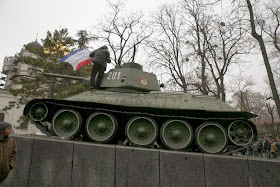by Benson Agoha | Aviation
Modern inventors may think they are the ones creating change. Perhaps they are just improving on one.
But changes have always come and gone and all we do is modify on change.Sometimes, we do so at such frequency that, with he passage of time, they seem to have happened in a whim.
On such change is the Concorde, shown in flight above and below. At the time of its conceptions in the 1970s, it took about 6.18 hours to fly the 3,459 miles distance between London and New York.The arrival of the Concorde, a co-operation between Airbus, BAE Systems, British Aircraft Corporation, Sud Aviation, Aerospatiale, brought a real CHANGE - halving the flying time between Europe and New York to just about three hours.
It's turbojet-powered supersonic engine delivered a maximum speed that was over twice the speed of sound at Mach 2.04.
But changes have always come and gone and all we do is modify on change.Sometimes, we do so at such frequency that, with he passage of time, they seem to have happened in a whim.
On such change is the Concorde, shown in flight above and below. At the time of its conceptions in the 1970s, it took about 6.18 hours to fly the 3,459 miles distance between London and New York.The arrival of the Concorde, a co-operation between Airbus, BAE Systems, British Aircraft Corporation, Sud Aviation, Aerospatiale, brought a real CHANGE - halving the flying time between Europe and New York to just about three hours.
It's turbojet-powered supersonic engine delivered a maximum speed that was over twice the speed of sound at Mach 2.04.
 |
| * April 1985 Concorde flies supersonic G-BOAG This is a dramatic picture of Concorde flying at supersonic speed. |
The Concorde was introduced on January 21, 1976 but had to be forced to retire on November 26, 2003, following one of the worst air mishaps, that killed the majority of German tourists that boarded it for New York.
But although the Concorde entered service in 1976, it was actually first flown in 1969. It has a seating capacity of between 92 and 128 passengers - often, it was fully booked. It's sound was awesome.
Between 1969 and 1976 the Concorde had to be tested and retested and with a Rolls-Royce/Snecma Olympus 593 engine that delivers a top speed of 2,179 km/h, it was the ultimate flying experience. It has seating for between 92 and 128 passengers.
First flown in 1969, Concorde entered service in 1976 and continued flying for the next 27 years. It is one of only two supersonic transports to have been operated commercially; the other is the Soviet-built Tupolev Tu-144, which was operated for a much shorter period of time.
A planned supersonic jet by US owned Boeing, never got to leaving the hanger.
The photo, as Pilot Josh Masterson explains, was the only picture ever taken of Concorde flying at Mach 2 (1,350 mph), close to its top speed of 2.179 km/h.
He said: "It was taken from an RAF Tornado fighter jet, which only rendezvoused with Concorde for 4 minutes over the Irish Sea: The Tornado was rapidly running out of fuel, struggling to keep up with Concorde at Mach 2."
He said: "It was taken from an RAF Tornado fighter jet, which only rendezvoused with Concorde for 4 minutes over the Irish Sea: The Tornado was rapidly running out of fuel, struggling to keep up with Concorde at Mach 2."
But if the Concorde was fast and the ultimate flying Experience, the latest attempt Airbus to develop an aircraft that will reduce the travel time between Europe and America to just one hour promises a real change.
In August 2015 a report emerged that Airbus had filed papers to patent a design for a hypersonic jet more than double the speed of Concorde. It will be so fast, it will require only one-third of the time it took the Concorde to reach America from Europe.
Now CHANGE builds from change, doesn't it?
In August 2015 a report emerged that Airbus had filed papers to patent a design for a hypersonic jet more than double the speed of Concorde. It will be so fast, it will require only one-third of the time it took the Concorde to reach America from Europe.
Now CHANGE builds from change, doesn't it?

















































































































































































No comments:
Post a Comment